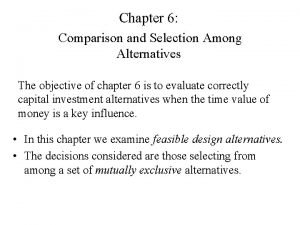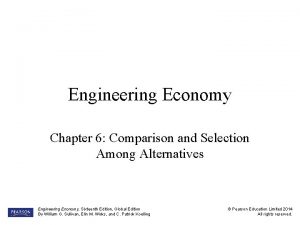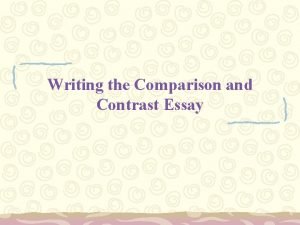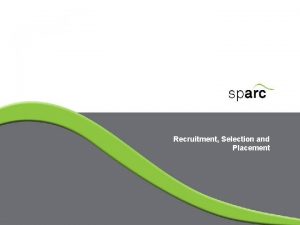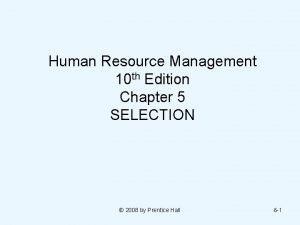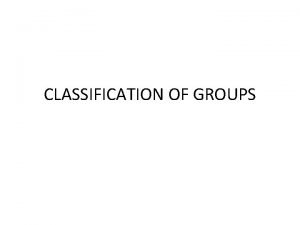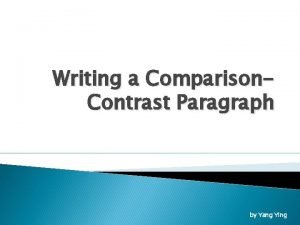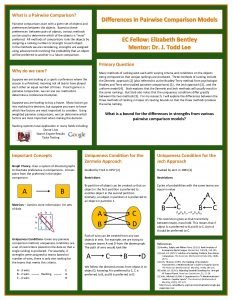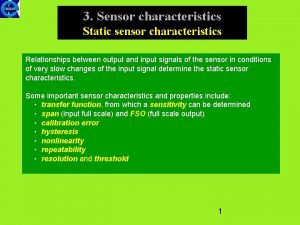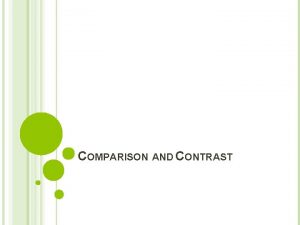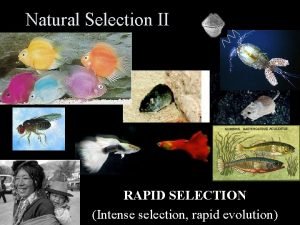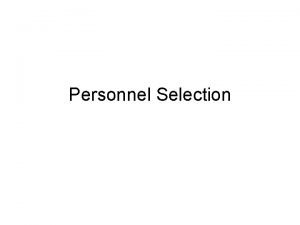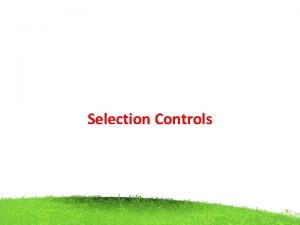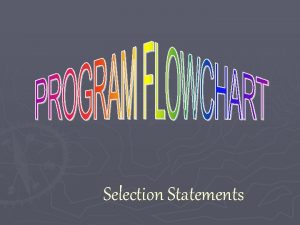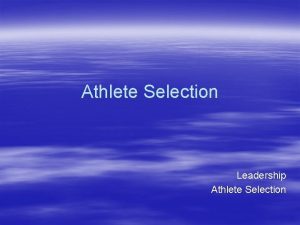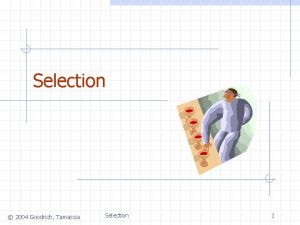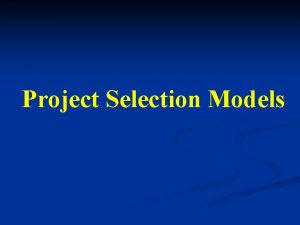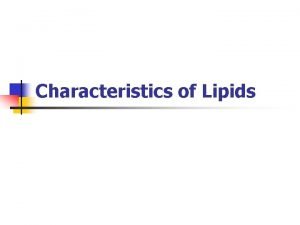Outline Sensor characteristics Sensor selection Sensor comparison Sensor





![Accuracy and Precision [Ref] Joey Parker Accuracy and Precision [Ref] Joey Parker](https://slidetodoc.com/presentation_image_h2/9d51d682f65ff986bf9de8fce93102fa/image-6.jpg)

![Linearity [Ref] Joey Parker Linearity [Ref] Joey Parker](https://slidetodoc.com/presentation_image_h2/9d51d682f65ff986bf9de8fce93102fa/image-8.jpg)

![Saturation and Deadband [Ref] Joey Parker Saturation and Deadband [Ref] Joey Parker](https://slidetodoc.com/presentation_image_h2/9d51d682f65ff986bf9de8fce93102fa/image-10.jpg)




![Linear and Rotational Sensors [Ref. ] Anjanappa, Datta, and Song Linear and Rotational Sensors [Ref. ] Anjanappa, Datta, and Song](https://slidetodoc.com/presentation_image_h2/9d51d682f65ff986bf9de8fce93102fa/image-15.jpg)









- Slides: 24


Outline �Sensor characteristics �Sensor selection �Sensor comparison

Sensor Characteristics �Range Difference between the maximum and minimum value of the sensed parameter �Resolution The smallest change the sensor can differentiate. For digital sensors, it is related to number of bits used For analog sensors, it is limited by low-level electrical noise �Sensitivity Ratio of change in output to a unit change of the input For digital sensors, sensitivity is closely related to resolution For analog sensors, sensitivity is the output slope vs. input line

Sensor Sensitivity

Sensor Characteristics �Error Difference between the measured value and the true value. Two classifications: bias and random �Accuracy Inversely proportional to the error Sometimes related to the sensor’s linearity �Precision Ability to reproduce repeatedly with a given accuracy Sometimes called repeatability
![Accuracy and Precision Ref Joey Parker Accuracy and Precision [Ref] Joey Parker](https://slidetodoc.com/presentation_image_h2/9d51d682f65ff986bf9de8fce93102fa/image-6.jpg)
Accuracy and Precision [Ref] Joey Parker

Sensor Characteristics � Linearity Percentage of deviation from the best-fit linear calibration curve Linearity means superposition principle Most systems have nonlinear behavior � Impedance Ratio of voltage to current Two types: input and output impedance Input impedance Measure of how much current must be drawn to power the sensors Modeled as resistor in parallel High input impedance is desirable Output impedance Sensors ability to provide current to next stage Modeled as resistor is series with the sensor output Low output impedance is desirable
![Linearity Ref Joey Parker Linearity [Ref] Joey Parker](https://slidetodoc.com/presentation_image_h2/9d51d682f65ff986bf9de8fce93102fa/image-8.jpg)
Linearity [Ref] Joey Parker

Sensor Characteristics �Saturation Maximum output capability, regardless of input �Deadband The range of input for which there is no output �Zero offset A nonzero value output for no input �Zero Drift The departure of output from zero value over a period of time for no input
![Saturation and Deadband Ref Joey Parker Saturation and Deadband [Ref] Joey Parker](https://slidetodoc.com/presentation_image_h2/9d51d682f65ff986bf9de8fce93102fa/image-10.jpg)
Saturation and Deadband [Ref] Joey Parker

Sensor Characteristics �Response time The time lag between the input and output �Bandwidth Frequency at which the output magnitude drops by 3 d. B �Resonance The frequency at which the output magnitude peak occurs �Operating temperature The range in which the sensor performs as specified �Signal-to-noise ratio Ratio between the magnitudes of the signal and the noise at the output

Sensor Selection Criteria �Variables measured and application �Dynamic range �Required resolution and sensitivity �Required accuracy and precision �Environmental conditions �Power available for sensing

Sensor Selection Criteria �Availability �Cost �Size and available space �Ease of use �Ease of maintenance �Required signal processing

Sensor Comparisons �Linear and rotational �Acceleration �Force and Torque �Flow �Temperature �Proximity �Light �Smart material
![Linear and Rotational Sensors Ref Anjanappa Datta and Song Linear and Rotational Sensors [Ref. ] Anjanappa, Datta, and Song](https://slidetodoc.com/presentation_image_h2/9d51d682f65ff986bf9de8fce93102fa/image-15.jpg)
Linear and Rotational Sensors [Ref. ] Anjanappa, Datta, and Song

Acceleration Sensors

Force, Torque, and Pressure Sensors

Flow Sensors

Temperature Sensors

Proximity Sensors

Light Sensors

Smart Material Sensors

Macro and Nano Sensors

Actuator Selection 1. Introduction One of the most critical decisions the mechatronics engineering designer has to make is the selection of the type and size of motor required for the mechatronic system. The actuator system is the part that executes the requirements of the controller in the plant. It receives a signal from the controller (called the control signal) and send an output power signal (e. g. Force, torque, heat power, pressure) to the plant. In order to do this, it needs a source of power, such as electrical power or pressure (e. g. hydraulic or pneumatic). We can think of the actuator as modulating the power it receives based on the control signal.
 Limit convergence test
Limit convergence test Comparison and selection among alternatives
Comparison and selection among alternatives Comparing alternatives engineering economy
Comparing alternatives engineering economy Block organization essay
Block organization essay Balancing selection vs stabilizing selection
Balancing selection vs stabilizing selection Similarities
Similarities K selection r selection
K selection r selection Natural selection vs artificial selection
Natural selection vs artificial selection Artificial selection vs natural selection
Artificial selection vs natural selection 5 points of natural selection
5 points of natural selection Logistic model of population growth
Logistic model of population growth Natural selection vs artificial selection
Natural selection vs artificial selection Two way selection and multiway selection
Two way selection and multiway selection Multiway selection
Multiway selection Mass selection and pure line selection
Mass selection and pure line selection Recruitment selection and placement
Recruitment selection and placement Quote sandwich examples
Quote sandwich examples If katie has brown eyes a dominant trait we know
If katie has brown eyes a dominant trait we know Characteristics of properly designed selection tests
Characteristics of properly designed selection tests Characteristics of effective selection techniques
Characteristics of effective selection techniques Unadjusted top down selection
Unadjusted top down selection Outline the characteristics of primary groups
Outline the characteristics of primary groups How to write a contrast paragraph
How to write a contrast paragraph Pairwise comparison
Pairwise comparison Dra comparison chart
Dra comparison chart

